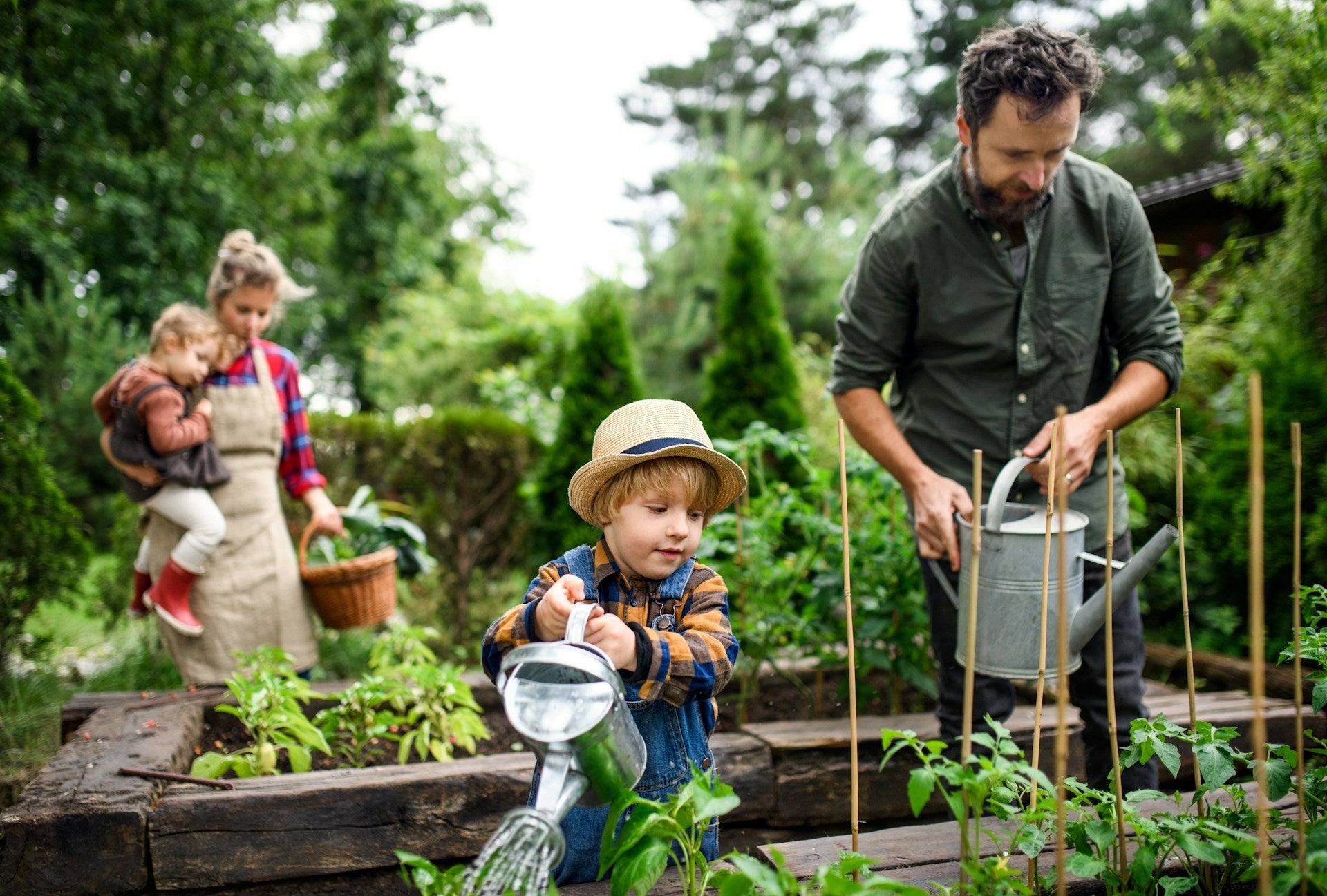The Ultimate Guide to Regenerative Gardening
Welcome to the world of regenerative gardening, a practice that goes beyond traditional gardening to create ecosystems that are productive, sustainable, and beneficial to the environment. In this journey, you'll learn how to work with nature rather than against it, transforming your backyard into a thriving, self-sustaining oasis. This guide introduces you to six fundamental techniques that embody the principles of regenerative agriculture. They will help you enhance soil health, conserve water, promote biodiversity, and ensure a vibrant and resilient garden ecosystem. They'll also help you produce more nutrient-dense foods to nourish your body, mind, and spirit. Whether you're an experienced gardener or just starting, these practices are simple to implement and will make a significant difference in the health of your garden and the environment.

1. Soil Health is Paramount
The journey to a regenerative garden begins beneath our feet - with the soil. Healthy soil is the foundation of any thriving garden, acting as a reservoir of nutrients, a habitat for microorganisms, and a buffer against pests and diseases. By focusing on building and maintaining rich, fertile soil, you're setting the stage for a garden that grows healthy plants and contributes to the planet's health. In this section, we'll explore how composting, no-till gardening, and cover crops can improve soil structure, increase biodiversity, and boost the overall productivity of your garden.
Composting
Composting is the process of turning organic waste into nutrient-rich soil. It's a fantastic way to recycle kitchen scraps and garden waste while improving soil fertility. The compost feeds the soil, which feeds your plants, creating a closed-loop system that mimics natural cycles. There are many ways to compost, so we'll revisit this subject later. In the meantime, explore different methods and find one that works best for your lifestyle.
No-Till Gardening
No-till gardening is about minimizing disturbance to the soil's structure. Tilling can disrupt the natural soil biome, so adopting a no-till or minimal tillage approach helps preserve underground biodiversity, which is vital for nutrient cycling and soil health. When establishing your garden, some tillage may be necessary to create room for your new plants and vegetables to absorb nutrients and thrive. However, it is a common misperception that you should "work" the soil. The soil and plants are already doing the work!
Cover Crops
In the off-season, growing cover crops like clover or rye protects and enriches the soil. These plants add organic matter, prevent erosion, and can fix nitrogen, a crucial nutrient for plant growth. Cover crops can also improve carbon sequestration, limit nutrient runoff, and help suppress some pests.

2. Plant Diversity
Diversity is the hallmark of a resilient ecosystem, which also holds true in regenerative gardening. Introducing a variety of plants into your garden creates a more balanced and self-sustaining environment. Diverse plantings make for a more beautiful and interesting garden and promote a healthier one. They attract beneficial insects, improve soil health, and reduce the likelihood of pest outbreaks. This section delves into achieving plant diversity through a mix of species, companion planting, and crop rotation.
Variety of Species
Incorporate a mix of vegetables, herbs, flowers, and shrubs to attract beneficial insects and improve pollination. This diversity also makes your garden more resilient to pests and diseases.
Companion Planting
Planting certain species together can benefit both, such as marigolds with tomatoes to deter pests. Companion planting enhances your garden's biodiversity and can improve your crops' flavor and yield. Here are some common and effective companion planting combinations:
- Tomatoes and Basil: Basil is known to repel flies and mosquitoes and may also enhance the flavor of the tomatoes.
- Carrots and Chives: Chives can help improve carrots' flavor and deter carrot flies.
- Cucumbers and Nasturtiums: Nasturtiums are a great companion for cucumbers as they repel pests that commonly affect cucumber plants.
- Corn, Beans, and Squash (The Three Sisters): This Native American planting technique involves growing these three plants together. Beans fix nitrogen in the soil, corn provides a structure for the beans to climb, and squash spreads along the ground, blocking sunlight and preventing weed growth.
- Lettuce and Tall Flowers: Planting lettuce under taller flowers or plants, like sunflowers, can provide much-needed shade for the lettuce, especially in warmer climates.
- Onions and Carrots: Onions can deter carrot flies, while carrots can ward off onion flies, making them excellent companions.
- Marigolds and Just About Anything: Marigolds are a popular companion plant due to their ability to deter a variety of pests. They are often planted around the edges of garden beds.
- Peppers and Basil: Basil can help repel aphids, spider mites, mosquitoes, and flies, and it's said to improve the flavor of peppers.
- Tomatoes and Marigolds: Marigolds help to repel nematodes that can attack tomato roots.
- Cabbage and Dill: Dill attracts beneficial wasps that can control pests like cabbage worms.
- Strawberries and Borage: Borage strengthens strawberries' resistance to pests and disease and can also improve their flavor.
Crop Rotation
Rotating your crops each year helps prevent soil depletion and interrupts pest and disease cycles. This practice ensures that the soil remains fertile and your plants are healthy.

3. Water Conservation
Water is a precious resource, and conserving it is a key principle of regenerative agriculture. Efficient water use in the garden conserves this vital resource and creates a more resilient garden. In this part, we'll explore sustainable ways to manage water, from rainwater harvesting and mulching to implementing drip irrigation systems. These techniques ensure that your garden remains lush and productive, even in times of limited water availability, and help you play a part in preserving the environment's natural water cycles.
Rainwater Harvesting
Setting up rain barrels or creating rain gardens can maximize the use of natural rainfall. This method of water conservation is not only sustainable but also reduces dependence on external water sources.
Mulching
A thick layer of organic mulch around your plants keeps the soil moist and reduces the need for frequent watering. Mulch also adds organic matter to the soil as it breaks down. One of the key principles in regenerative agriculture is circularity. You can grow your mulch and use it in your garden rather than buying mulch and using resources to transport it to your home.
Drip Irrigation
A drip irrigation system delivers water directly to the base of each plant. This efficient method reduces water loss through evaporation and prevents water wastage. However, the plastic tubing used in drip irrigation can leach harmful chemicals into your soil, especially on the hot days. If you live in a hot, dry climate, take some time to research indigenous and innovative methods for drip irrigation that avoid the use of plastic materials. For example, clay pots placed underground can collect rainwater and slowly release water to surrounding plants.

4. Integrate Perennials
Perennials are the stalwarts of a regenerative garden, bringing stability, resilience, and long-term productivity. Unlike annuals, which need to be replanted each year, perennials come back season after season, often growing stronger and more productive over time. In this section, we'll look at the benefits of integrating perennials into your garden landscape, from deep-rooted varieties that improve soil structure to fruit-bearing trees and shrubs that provide food and habitat for wildlife.
Long-Living Plants
Perennials, like fruit trees and asparagus, grow for several years, requiring less disturbance to the soil. Their deeper root systems help aerate the soil and increase water infiltration.
Edible Landscaping
Incorporating edible perennials into your landscaping provides food and creates a habitat for beneficial wildlife. These plants can also serve as windbreaks and provide shade, creating microclimates within the garden.
Pollinator Attractions
Many perennial plants are excellent at attracting pollinators. Including a variety of flowering perennials ensures a constant food source for bees and other beneficial insects throughout the growing season. Bees are responsible for pollinating about one-third of the world's food supply, so it's critical that we create beneficial habitats for these powerhouse pollinators.

5. Encourage Beneficial Insects and Wildlife
A regenerative garden is a haven for wildlife, providing habitats for beneficial insects and animals that contribute to the garden’s health and vitality. By encouraging a diverse range of life in your garden, you enhance its ability to self-regulate and maintain balance. This part of the guide will introduce ways to attract and support beneficial insects and wildlife, from creating pollinator-friendly spaces to implementing natural pest control methods.
Habitat for Pollinators
Flowering plants, insect hotels, and water features can create habitats for pollinators and beneficial insects. These habitats are crucial for maintaining ecological balance and supporting natural pest control.
Natural Pest Control
Encouraging a variety of insect life in your garden helps keep pest populations in check. Beneficial insects like ladybugs and lacewings can naturally control common garden pests.
Bird and Bat Houses
Installing bird and bat houses can attract these natural predators to your garden. They help control insect populations and contribute to the overall health of your garden ecosystem.

6. Continuous Learning and Adaptation
Regenerative gardening is an evolving practice rooted in observation, learning, and adaptation. It's about being in tune with your garden and the natural world and continually adjusting your practices to suit the changing environment. This final section emphasizes the importance of ongoing education and experimentation in regenerative agriculture. We'll discuss how to stay informed, adapt techniques to your specific environment, and share your experiences to contribute to the broader community of sustainable gardeners.
Educate Yourself
Science, and thus gardening, is a never-ending journey of discovery. Stay informed about sustainable gardening practices through YouTube tutorials, workshops, and gardening groups. Whatever you do, keep learning. New (and old) techniques can continuously improve your gardening game.
Experiment and Observe
Feel free to experiment and observe what works best in your garden. Each space is unique, and part of the journey is discovering what works for your specific environment. Keep a journal to note what's working and what isn't so you can incorporate your learnings into next year's gardenscape.
Share and Collaborate
Share your experiences with other gardeners and collaborate to spread the principles of regenerative agriculture within your community. It will have a compounding effect as we work together to improve our soil, air, and water quality.
Embracing regenerative agriculture practices in your backyard garden is a powerful step towards creating a more sustainable, environmentally aware, and nurturing world. These six simple ways offer a roadmap to a garden that nourishes the body and heals the earth. As you implement these practices, you'll find that regenerative gardening is not just about growing plants – it's about cultivating a healthier planet for future generations.




This information was very helpful thank you
Leave a comment